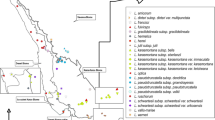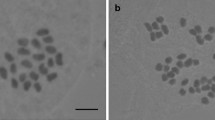Abstract
The Bulbophyllum exaltatum complex comprises 15 described taxa, and present a number of unresolved taxonomic questions, especially among populations found in the Brazilian campo rupestre vegetation. Allozymes were examined in 33 populations to determine the degree of genetic variability between them and their degree of differentiation to better define the taxa of this group. Additionally morphometric analyses were also performed on representatives of 24 populations. All of the populations examined demonstrated high levels of variability and none of the species formed distinct groups comprising all of the conspecific populations. However, the populations primarily grouped according to their regional occurrence, with a distinction between populations of the states of Minas Gerais and Bahia, which coincided with the geophysical disjunction of the mountain chains where they occur. It is probable that hybridization or incipient differentiation is contributing to the elevated genetic identity observed among the populations, generating a reticulated grouping pattern.
Similar content being viewed by others
References
Azevedo CO, Borba EL, van den Berg C (2006) Evidence of natural hybridization and introgression in Bulbophyllum involutum Borba, Semir& F.Barros and B. weddellii (Lindl.) Rchb.f. (Orchidaceae) in the Chapada Diamantina, Brazil, by using allozyme markers. Rev Brasil Bot 29: 415–421
Azevedo MTA, Borba EL, Semir J, Solferini VN (2007) Very high genetic variability in Neotropical myophilous orchids. Bot J Linn Soc 153: 33–40
Barkman TJ, Simpson BB (2002) Hybrid origin and parentage of Dendrochilum acuiferum (Orchidaceae) inferred in a phylogenetic context using nuclear and plastid DNA sequence data. Syst Bot 27: 209–220
Borba EL, Semir J (1998a) Bulbophyllum × cipoense (Orchidaceae), a new natural hybrid from the Brazilian campos rupestres: description and biology. Lindleyana 13: 113–120
Borba EL, Semir J (1998b) Wind-assisted fly pollination in three species of Bulbophyllum (Orchidaceae) occurring in the Brazilian campos rupestres. Lindleyana 13: 201–218
Borba EL, Semir J, Barros F (1998) Bulbophyllum involutum Borba, Semir& F. Barros (Orchidaceae), a new species from the Brazilian “campos rupestres”. Novon 8: 225–229
Borba EL, Semir J (1999) Temporal variation in pollinarium size after its removal in species of Bulbophyllum: a different mechanism preventing self-pollination in Orchidaceae. Plant Syst Evol 217: 197–204
Borba EL, Shepherd J, Semir J (1999) Reproductive systems and crossing potential in three species of Bulbophyllum (Orchidaceae) occurring in the Brazilian “campos rupestres”. Plant Syst Evol 217: 205–214
Borba EL, Semir J, Shepherd GJ (2001a) Self-incompatibility, inbreeding depression and crossing potential in five Brazilian Pleurothallis (Orchidaceae) species. Ann Bot 88: 89–99
Borba EL, Felix JM, Solferini VN, Semir J (2001b) Fly-pollinated Pleurothallis (Orchidaceae) species have high genetic variability: evidence from isozyme markers. Am J Bot 88: 419–428
Borba EL, Shepherd GJ, van den Berg C, Semir J (2002) Floral and vegetative morphometrics in five Pleurothallis (Orchidaceae) species: correlation with taxonomy, phylogeny, genetic variability and pollination systems. Ann Bot 90: 219–230
Braga PIS (1977) Aspectos biológicos das Orchidaceae de uma campina na Amazônia Central. Acta Amazônica 7(suppl 2): 1–89
Brune W, Alfenas AC, Junghans TG (1998) Identificações específicas de enzimas em géis. In: Alfenas AC (ed) Eletroforese de isoenzimas e proteinas afins: fundamentos e aplicações em plantas e microorganismos. Universidade Federal de Viçosa, Viçosa, pp 201–328
Christensen DE (1994) Fly pollination in the Orchidaceae. In: Arditti J (ed) Orchid biology: reviews and perspectives VI. John Wiley& Sons, New York, pp 415–454
Chung MY, Chung MG (1999) Allozyme diversity and population structure in Korean population of Cymbidium goeringii (Orchidaceae). J Plant Res 112: 139–144
Chung MG, Chung MY, Oh GS, Epperson BK (1998) Spatial genetic structure in populations of Cymbidium goeringii (Orchidaceae). Genes Genet Syst 73: 281–285
Chung MY, Nason JD, Chung MG (2004) Spatial genetic structure in populations of the terrestrial orchid Cephalanthera longibracteata (Orchidaceae). Am J Bot 91: 52–57
Clegg MT (1989) Molecular diversity in plant populations. In: Brown AHD, Clegg MT, Kahler AL, Weir BS (eds) Plant population genetics, breeding and genetic resources. Sinauer, Sunderland, pp 98–115
Corrias R, Rossi W, Arduino P, Cianchi R, Bullini L (1991) Orchis longicornu Poiret in Sardinina: genetic, morphological and chorological data. Webbia 45: 71–101
Crawford DJ (1989) Enzyme eletrophoresis and plant systematics. In: Soltis ED, Soltis PS (eds) Isozymes in plant biology. Dioscorides Press, Portland, pp 146–164
Crow JF, Aoki K (1984) Group selection for a polygenic behavioral trait: estimating the degree of population subdivision. Proc Natl Acad Sci USA 81: 6073–6077
Dressler RL (1993) Phylogeny and classification of the orchid family. Dioscorides Press, Portland
Ehlers BK, Pedersen HAE (2000) Genetic variation in three species of Epipactis (Orchidaceae): geographic scale and evolutionary inferences. Biol J Linn Soc 69: 411–430
Farinaci JS (2001) Variabilidade genética em algumas espécies de Bulbophyllum Thouars (Orchidaceae) de campos rupestres. Master Thesis, Universidade Estadual de Campinas, Campinas
Felsenstein J (1993) PHYLIP (Phylogeny Inference Package) version 3.6, University of Washington, Department of Genetics, Seattle
Giulietti AM, Pirani JR (1988) Patterns of geographic distribution of some plant species from the Espinhaço Range, Minas Gerais and Bahia, Brazil. In: Vanzolini PE, Heyer WR (eds) Proceedings of a workshop on Neotropical distribution patterns. Academia Brasileira de Ciências, Rio de Janeiro, pp 39–69
Gower JC (1971) A general coefficient of similarity and some one of its properties. Biometrics 27: 857–872
Hamrick JL, Godt MJ (1990) Allozyme diversity in plant species. In: Brown AHD, Clegg MT, Kahler AL, Weir BS (eds) Plant population genetics, breeding and genetic resources. Sinauer, Sunderland, pp 43–63
Harley RM (1988) Evolution and distribution of Eriope (Labiatae) and its relatives in Brazil. In: Vanzolini PE, Heyer WR (eds) Proceedings of a workshop on neotropical distribution patterns. Academia Brasileira de Ciências, Rio de Janeiro, pp 71–120
Hollingsworth PM, Dickson JH (1997) Genetic variation in rural and urban populations of Epipactis helleborine (L.) Crantz. (Orchidaceae) in Britain. Bot J Linn Soc 123: 321–331
Jesus FF, Solferini VN, Semir J, Prado PI (2001) Local genetic differentiation in Proteopsis argentea (Asteraceae), a perennial herb endemic in Brazil. Plant Syst Evol 226: 59–68
Klier K, Leoschke MJ, Wendel JF (1991) Hybridization and introgression in white and yellow landyslipper orchids (Cypripedium candidum and C. pubescens). J Hered 82: 305–318
Kumar S, Tamura K, Nei M (2004) MEGA3: Integrated software for molecular evolutionary genetics analysis and sequence alignment. Brief Bioinformatics 5: 150–163
Lambert SM, Borba EL, Machado MC, Andrade SCS (2006a) Allozyme diversity and morphometrics of Melocactus paucispinus (Cactaceae) and evidence for hybridization with M. concinnus in the Chapada Diamantina, North-eastern Brazil. Ann Bot 97: 389–403
Lambert SM, Borba EL, Machado MC (2006b) Allozyme diversity and morphometrics of the endangered Melocactus glaucescens (Cactaceae), and investigation of the putative hybrid origin of Melocactus × albicephalus (Melocactus ernestii × M. glaucescens) in north-eastern Brazil. Plant Sp Biol 21: 93–108
Levene H (1949) One matching problem arising in genetics. Ann Math Statist 20: 91–94
Levin DA (2000) The origin, expansion, and demise of plant species. Oxford University Press, New York
Machado MC, Zappi DC, Borba EL, Lambert SM (in press) Genetic variability of three Discocactus Pfeiff. (Cactaceae) species from the state of Bahia, Brazil. Syst Bot
McCune B, Mefford MJ (1999) PCOrd - Multivariate analysis of ecological data, version 4.10. MjM Software, Gleneder Beach
Miller MP (1997) Tools for population genetics analysis (TFPGA) 1.3: A windows program for the analysis of allozyme and molecular population genetic data. Distributed by the author
Murren CJ, Ellison AM (1998) Seed dispersal characteristics of Brassavola nodosa (Orchidaceae). Amer J Bot 85: 675–680
National Geodetic Survey (2002) INVERSE - Version 2.0. http://ngs.noaa.gov/. 18 Apr. 2006
Nei M (1972) Genetic distance between populations. Am Nat 106: 283–292
Nei M (1978) Estimation of average heterozigosity and genetic distance from a small number of individuals. Genetics 89: 583–590
Nielsen LR (2000) Natural hybridization between Vanilla claviculata (W.Wright) Sw. and V. barbellata Rchb.f. (Orchidaceae): genetic, morphological, and pollination experimental data. Bot J Linn Soc 133: 285–302
Pereira ACS, Borba EL, Giulietii AM (2007). Genetic and morphological variability of the endangered Syngonanthus mucugensis Giul. (Eriocaulaceae), from the Chapada Diamantina, Brazil: implications for conservation and taxonomy. Bot J Linn Soc 153: 401–416
Raymond M, Rousset F (1995) GENEPOP (version 1–2): population genetics software for exact tests and ecumenicism. J Hered 86: 248–249
Ribeiro PL, Borba EL, Toscano de Brito ALV (2005) O gênero Bulbophyllum Thouars (Orchidaceae) na Chapada Diamantina, Bahia, Brasil. Rev Brasil Bot 28: 423–439
Rice WR (1989) Analyzing tables of statistical tests. Evolution 43: 223–225
Sazima M (1978) Polinização por moscas em Bulbophyllum warmingianum Cogn. (Orchidaceae) na Serra do Cipó, Minas Gerais, Brasil. Rev Brasil Bot 1: 133–138
Sharma IK, Clements MA, Jones DL (2000) Observations of high genetic variability in the endangered Australian terrestrial orchid Pterostylis gibosa R. Br. (Orchidaceae). Biochem Syst Ecol 28: 651–663
Shepherd GJ (1995) FITOPAC 1. Universidade Estadual de Campinas, Campinas
Silva UF, Borba EL, Semir J, Marsaioli AJ (1999) A simple solid injection device for the analyses of Bulbophyllum (Orchidaceae) volatiles. Phytochemistry 50: 31–34
Slatkin M, Barton NH (1989) A comparison of three indirect methods for estimating average levels of gene flow. Evolution 43: 1349–1368
Sneath PHA, Sokal RR (1973) Numerical taxonomy. Freeman and Co, San Francisco
Soliva M, Widmer A (1999) Genetic and floral divergence among sympatric of Gymnadenia conopsea s.l. Int J Plant Sci 160: 897–910
Soltis DE, Haufler CH, Darrow DC, Gastony GJ (1983) Starch gel electrophoresis of ferns: a compilation of grinding buffers, gel and electrode buffers, and staining schedule. Am Fern J 73: 9–27
StatSoft INC (2003) STATISTICA (data analysis software system), version 6.1. StatSoft, Tulsa
Swofford DL (2000) PAUP* 4.1: phylogenetic analysis using parsimony (*and other methods). Sinauer, Sunderland
Swofford DL, Selander RB (1989) BIOSYS-1: computer program for the analysis of allelic variation in population genetics and biochemical systematics. Natural History Survey, Champain
Trapnell DW, Hamhick JL, Nason JD (2004) Three-dimensional fine-scale structure of the neotropical epiphytic orchid, Laelia rubescens. Mol Ecol 13: 1111–1118
Tremblay RL, Ackerman JD (2001) Gene flow and effective population size in Lepanthes (Orchidaceae): a case for genetic drift. Biol J Linn Soc 72: 47–62
van der Bank H, van der Bank M, van Wyk B (2001) A review of the use of allozyme electrophoresis in plant systematics. Biochem Syst Ecol 29: 469–483
van der Pijl L, Dodson CH (1966) Orchid flowers: their pollination and evolution. University of Miami Press, Coral Gables
Verola CF (2002) Biologia floral e sistemas de reprodução em espécies de Bulbophyllum (Orchidaceae) ocorrentes em mata de galeria, campo rupestre e floresta estacional. Master Thesis, Universidade Estadual de Campinas, Campinas
Weir BS, Cockerham CC (1984) Estimating F-statistic for the analysis of population-structure. Evolution 38: 1358–1370
Wright S (1951) The genetical structure of populations. Ann Eugen 15: 323–354
Wright S (1978) Evolution and the genetics of populations. Variability within and among natural populations, vol. 4. University of Chicago Press, Chicago
Author information
Authors and Affiliations
Corresponding author
Rights and permissions
About this article
Cite this article
Ribeiro, P.L., Borba, E.L., de Camargo Smidt, E. et al. Genetic and morphological variation in the Bulbophyllum exaltatum (Orchidaceae) complex occurring in the Brazilian “campos rupestres”: implications for taxonomy and biogeography. Plant Syst Evol 270, 109–137 (2008). https://doi.org/10.1007/s00606-007-0603-5
Received:
Accepted:
Published:
Issue Date:
DOI: https://doi.org/10.1007/s00606-007-0603-5




